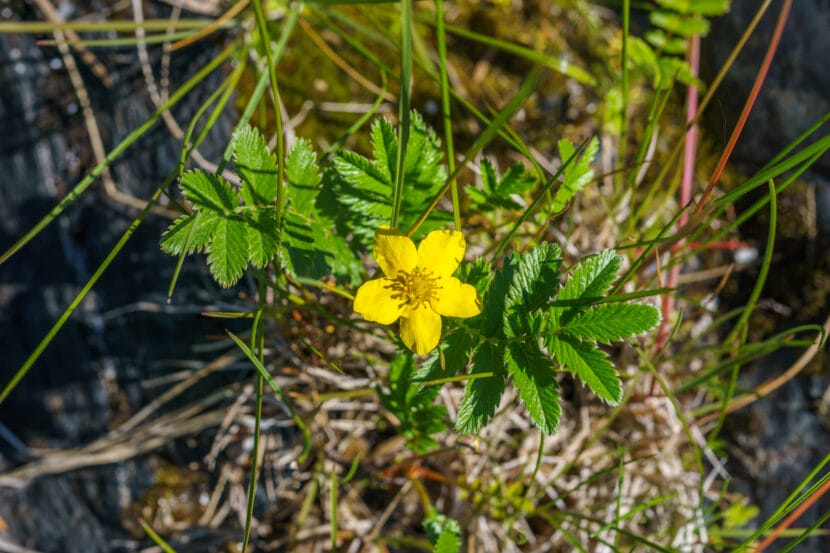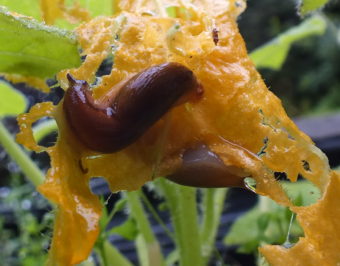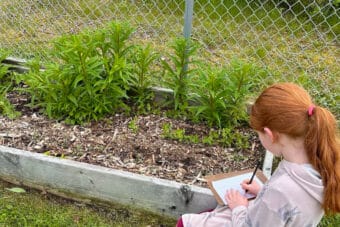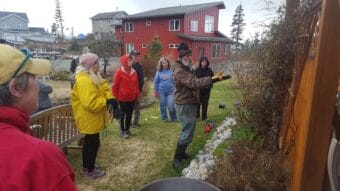
For this week’s Garden Talk, KTOO’s Chloe Pleznac spoke with Khalil English about his research on silverweed, a seemingly inconspicuous plant with deep roots in Pacific Northwest history. English spoke about silverweed’s importance as a food source across the North — and about where it grows in Juneau.
Listen:
This transcript has been lightly edited for clarity and length.
Khalil English: Silverweed first came into my life, I believe, through a book that I got from Professor Daniel Monteith called Haa Atxaayí Haa Kusteeyíx Sitee. It means, “Our food is our Lingít way of life.” And there are some plant foods in there that I had never heard of before, and one of them was tséit or silverweed. And that kind of just grew into something huge. I looked into some of the Lingít uses and how it’s harvested here, and then found, oh my gosh, it’s a beloved plant all throughout the Pacific Northwest and even circumboreal. It’s all around the North, and even in Europe, in Scotland, and Norway, etc. People have loved silverweed. So it ended up becoming a little bit of a self-history search, as well.
Chloe Pleznac: Can you tell me a little bit more about what some of those traditional uses are and how this plant fits into the history of all the indigenous cultures along the Pacific Northwest Coast? And even the circumpolar north, as you were saying.
Khalil English: A lot of the information that I have been able to learn comes from the Kwakwa̱ka̱ʼwakw, which are just the northern tip of Vancouver Island and a little bit on the mainland. And that’s where the temperate rainforest, it’s just non-stop, summer and winter rain. So we have these huge estuarine river systems, and people would bioengineer the salt marsh. So according to sources from the Kwakwa̱ka̱ʼwakw, there was not a single patch of saltmarsh that wasn’t owned and tended by someone. So it was a very intensively managed crop. There was a lot of food that people got from it. It was very important ceremonially, there was actually a taboo, at least in this area, for not eating the silverweed until, I think it was at least, around December, which has a little bit to do with getting the roots to taste sweeter. And then as far as Scotland, there’s sadly not as much information, but there is still a lot of love. In some of the few stories I could find. There was a little Gaelic phrase that I learned that I’ll share that kind of highlights some of the feelings around it. And it’s, brisgean beannaichte an Earraich, seachdamh aran a’ Ghàidheil. It means “blessed silverweed of spring, seventh bread of Gales.” And so along with millet and rye and wheat, silverweed was very important. And so people, when they were given their allotments for fishing, etc, silverweed patches were a part of that, at least in Scotland. And then when the potato famine happened, people actually returned to eating silverweed.
Chloe Pleznac: Do you know why it kind of has become a little disenfranchised? Why is it not known as well as these other food sources?
Khalil English: I think it depends on where we’re looking. So, for silverweed in the British Isles, from what I’ve garnered, it’s the fact that it was mostly a food that poor people ate. That’s why it wasn’t recorded so much. When we’re looking at the Pacific Northwest, then we’re dealing with a little bit more of that kind of direct intention to remove people from their food and remove people from the land. So of course, where silverweed grows, is the easiest land to develop. It’s the easiest land to put cows on. And so people were removed from their silverweed fields. There’s quite a few disheartening stories of people kind of giving up on those fields and walking away.
Chloe Pleznac: Where can people in Juneau typically find silverweed and respectfully harvest it?
Khalil English: Silverweed is abundant. There are actually quite a few subspecies of silverweed. So Pacific silverweed is what I’ve mostly been focusing on. They have the biggest roots and they’re going to be mostly along the oceanside. But even for folks in interior Alaska, or I don’t know, in Utah, there is still silverweed. It prefers more salty grounds. So for us, that’s right on the oceanside, could be at the edge of some lake, down further South. More direct places in Juneau might be Fish Creek. The Mendenhall Wetlands would be the most ideal spot, but of course, I don’t know how safe it is to eat anything out of there given the airport and the waste management system. But pretty much anywhere. Like Sandy Beach, all the edges are covered in silverweed. Any beach, right under that beach rye, that really grayish blue grass that is very thick? Silverweed is right there.
Chloe Pleznac: What time of year is the best time to keep an eye out for this? You were saying culturally, there’s a bit of connection at different times of the year for harvesting, perhaps?
Khalil English: For our area, what I’ve read is mostly people would harvest in the spring. And then what I’ve read for down in Vancouver, people mostly harvested in the fall. But I think it’s a little interchangeable. What they’re going for is once the plant starts growing actively, once you can see anything above ground, the roots are very, very astringent. They become really bitter. There’s a lot of tannins. So, when you harvest either at the very beginning of spring or in the fall, those tannins have reduced a lot. Then when you dry them and store them cold, the tannin content is further reduced. So, in wintertime, you got to kind of familiarize yourself with habitat, and then you can go and look for their dried leaves. They persist pretty well and are easy to recognize. And then you just dig in.
One last thing I’ll share, and this was a little more of my focus, is something I’ve loved about silverweed, is it really highlights the relationship that people can and have for many thousands of years had with the earth. I think, too often when we’re talking about environmental topics, it becomes really depressing, and we kind of demonize ourselves. But, to me, this really highlights like, oh, we have a place we also are attending the earth as well. And by tending these wild systems, they can become more productive. We can take advantage of it and so can the rest of the wildlife. But in today’s world, of course, it’s a little harder to go out and say start bioengineering our salt marsh here. So, people can bring them into their gardens. They’re very adaptable.


